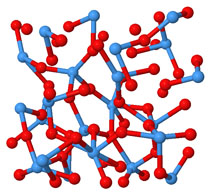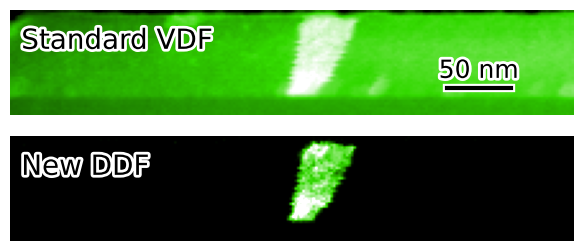Projects starting Oct 2025
Below are listed some representative projects for PhD study which could either be funded using research council support for applicants who fulfil the eligibility criteria, or by winning a competitive scholarship or self-funding: see the main Physics & Astronomy page for further details. If you are interested in one of these projects, please make direct contact with the academic responsible to discuss further concerning suitability, funding, and the formal application.
- Vibrational electron energy loss spectroscopy of nanostructured thermoelectric alloys, Prof Donald MacLaren
- Engineering novel ground states and excitations in quantum spin liquids, Dr David Boldrin
- Time resolved electron detection for electron microscopy of quantum materials, Dr Kayla Fallon & Prof Donald MacLaren
- Using electrons to fabricate magnetic nano-circuits, Dr Trevor Almeida
- Pressure-dependent synchrotron studies of barocaloric materials for zero carbon heating and cooling, Dr David Boldrin
- Atomic structures of optical coatings for ultrahigh-precision interferometry, Dr Ian Maclaren and Prof Sheila Rowan
- Digital Electron Diffraction and Imaging in 4DSTEM - Dr Ian MacLaren and Dr Syed Waqar Nabi (Computing Science)
Vibrational electron energy loss spectroscopy of nanostructured thermoelectric alloys
Scanning transmission electron microscopy (STEM) techniques have become essential to materials science, producing exquisite atom-resolved images of materials that are driving materials innovation. This project lies at the frontiers of STEM development and will pioneer the use a new, internationally-unique electron microscope facility that is being commissioned at the University of Glasgow. We will showcase improvements in energy and time resolution, using the technique of Electron Energy Loss Spectroscopy to drive developments in the design of materials for renewable energy technologies.
Electron monochromation has now pushed energy resolution in electron energy loss spectroscopy (EELS) to below 10meV whilst maintaining the atomic resolution of scanning transmission electron microscopy (STEM). This remarkable advance enables atomic-resolved studies of the vibrational excitations of materials, revealing the local molecular-dynamic properties that underpin phase transitions and thermal transport. The new technique of momentum-resolved EELS (mEELS) in STEM, in which scattered electrons are dispersed in both energy and momentum, has already yielded critical insights into the dynamics of a variety of functional materials. 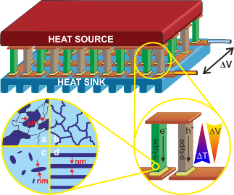
The aim of this project is to pioneer mEELS studies of an intriguing class of energy materials known as thermoelectrics. These can convert otherwise wasted heat energy directly into electrical power. Their conventional reliance on scarce resources has restricted them to niche applications including NASA’s Mars Rovers; but recent developments suggest that viable devices can be fabricated from cheaper alloys. The key insight is that well-chosen dopants can moderate heat-flow and thereby improve thermodynamic efficiency. However, it is unclear precisely how the phonons interact with the structural defects induced by doping. These low concentration, aperiodic structures are ideally suited to mEELS studies. The project will therefore pioneer mEELS measurements of thermoelectric alloys to develop insight into how to improve their efficacy.
This exciting project offers hands-on training and research with one of the world's best electron microscopes. It incorporates elements of theory and collaboration, with prospects for international facility usage. It will suit researchers with a background and passion for materials and/or chemical physics.
Engineering novel ground states and excitations in quantum spin liquids
The 40 year search for Quantum Spin Liquids (QSLs) is a cornerstone of condensed matter physics [1]. QSLs are novel states of matter that are the magnetic analogue of liquids; their magnetic moments remain fluctuating and never order. In addition, quantum effects mean these fluctuations persist even at zero temperature, leading to exotic emergent phenomena. Originally predicted to underpin high temperature superconductivity [2], the elusive search for QSLs has serendipitously led to some of the most groundbreaking discoveries in fundamental condensed matter physics [3,4]. Up to now, the search for QSLs is limited by the lack of model materials to study, the difficulty in making them and the challenges posed by characterising them. This project will build on our recent work addressing these bottlenecks by synthesising high quality samples of a recently discovered QSL model system and characterising its properties primarily with state-of-the-art neutron scattering techniques at national facilities across Europe, such as the ISIS Neutron and Muon Source and the Institut Laue-Langevin (ILL). In addition, the project will involve advanced characterisation using X-ray diffraction, SQUID magnetometry and electron microscopy within the Materials and Condensed Matter Physics (MCMP) group at UoG. The project builds on work with collaborators between a number of institutions, particularly the ILL, University College London and Université Paris-Saclay, and there will be opportunities for research visits to be involved in this collaborative work.
Please contact David Boldrin as soon as possible to discuss the project if it is of interest to you.
[1] C. Broholm et al., Science 367, 263 (2020).
[2] P. W. Anderson, Science 235, 1196 (1987).
[3] T.-H. Han et al., Nature 492, 406 (2012).
[4] Physics World, Electron’s dual nature appears in a quantum spin liquid, 2021
Time resolved electron detection for electron microscopy of quantum materials
Dr Kayla Fallon & Prof Donald MacLaren
Electron microscopy has been revolutionised in recent years with the development of direct electron detectors that offer fast, low noise and high sensitivity image capture. In Glasgow, a collaboration between the Experimental Particle Physics and Materials & Condensed Matter Physics groups led to the commercialisation of the Medipix camera for electron microscopy. That technology is now sold commercially by Quantum Detectors and has underpinned a variety of new experiments, where detecting every electron with time and spatial resolution really matters.
This project will help to develop the next generation of electron detectors. Our ambition is to push the time resolution of electron microscopy and spectroscopy into the nanosecond regime without the need for complex laser-stimulated experiments. The main aim is to incorporate a next-generation detector into a world-leading Iliad electron microscope spectrometer, which is currently being commissioned in Glasgow. We will perform electron energy loss spectroscopy with unrivalled energy, momentum and time resolution for the first time. The new detector will provide unique new capabilities to study transient excitations in materials that are currently too weak and too fast to detect. We will apply this remarkable improvement in resolution to study exotic electronic excitations in materials for quantum technologies. A first application will be nanosecond resolved analysis of plasmonic excitations in two dimensional materials. These electronic structures offer unusual stability and are proposed as a potential platform for robust quantum computing.
The project is a collaboration with microscope manufacturer Thermo Fischer and detector experts Quantum Detectors. It will suit highly-motivated students with an aptitude for computer programming and electronics, and an interest in materials physics.
Using electrons to fabricate magnetic nano-circuits
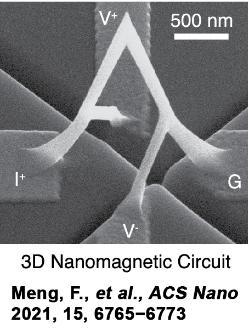
Next generation scanning electron microscopes have to ability to inject precursor gases for the fabrication of magnetic structures with dimensions as small as ~ 10 nm, called focused electron beam induced deposition (FEBID). Alteration of the electron-beam scan conditions during decomposition of the injected gases provides effective control over the composition, size and morphology of the deposited magnetic material. FEBID can be used to construct nano-scale circuits with complex geometries that provide interesting positions and paths for magnetic domain walls, which can be driven by application of current pulses and magnetic fields.
This project will be supervised by Dr Trevor Almeida, Lecturer in the Materials and Condensed Matter Physics group. The project will focus on fabricating nano-scale circuits using FEBID and characterising their chemical, structural and magnetic properties using advance electron microscopy techniques. In particular, focus will be placed on how joule heating / annealing affects the saturation magnetisation and domain wall motion through the FEBID structures. Another aspect would be optimising the magnetic imaging techniques for live imaging of dynamic magnetism within the nano-circuits. There will also be opportunities to take part in collaborative experiments at the Ernst Ruska-Centre for Microscopy and Spectroscopy with Electrons in Jülich.
New barocaloric materials for zero carbon heating and cooling
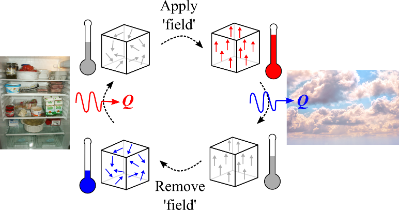
Heating and cooling result in over a third of the UK’s CO2 emissions and decarbonising these essential systems is imperative to reach the legal obligation of net-zero carbon by 2050 [1]. Barocalorics, materials that undergo large temperature changes under an applied pressure, are a promising technology to achieve this goal [2,3,4]. The challenge now is to tune these barocaloric effects away from the often-large operational hydrostatic pressures (>2.5 kbar), towards the low pressures (<1 kbar) required for a commercially competitive heating or cooling device. This project aims to develop new barocaloric materials that operate at low pressure. The number of materials that display barocaloric effects is rapidly expanding, from metallic magnets through polymers to metal-organic frameworks, meaning there are opportunities to investigate a number of different families of materials. The project would involve advanced characterisation using a number of probes, X-rays, synchrotrons, electrons and neutrons, with opportunities for experiments at large-scale facilities across Europe such as Diamond Light Source, ISIS Neutron and Muon Source and the Institut Laue-Langevin. The project would build on work with collaborators between a number of institutions, particularly Universitat Politècnica de Catalunya, Diamond Light Source and Imperial College London, and there will be opportunities to be involved in this collaborative work in addition to industrial engagement.
[1] Clean Growth - Transforming Heating, BEIS, (2018). https://www.gov.uk/government/publications/heat-decarbonisation-overview-of-current-evidence-base
[2] B. Li et al., Nature 567, 506 (2019).
[3] D. Boldrin, Appl. Phys. Lett. 118, 170502 (2021).
[4] https://www.royce.ac.uk/materials-for-the-energy-transition-caloric-energy-conversion/
Atomic structures of optical coatings for ultrahigh-precision interferometry
Dr Ian MacLaren and Prof Sheila Rowan
Various applications rely on ultrahigh precision interferometry including laser stabilisation and frequency stabilisation, laser gyroscopes for intertial guidance systems, quantum optical devices, and most especially, the gravitational wave interferometers used in the recent discovery of gravitational waves, binary black-hole mergers and neutron star mergers. One of the limitations on such interferometry is due to thermal noise in the amorphous optical coatings used in the multilayer mirrors at the ends of the interferometer arms. If this noise could be reduced, then the sensitivity of the interferometers can be further improved allowing better gravitational wave detection for a larger fraction of the universe. This thermal noise originates in atomic-scale processes which are poorly understood and to improve the materials requires an understanding of structures and dynamics at the atomic scale. This project will then focus on using cutting edge techniques in electron microscopy to provide information about the structure and chemistry of these coatings on sub-nanometre length scales. This work will involve extensive interaction with the Institute for Gravitational Research at the University of Glasgow, as well as with academic researchers at other UK Universities; Stanford University, California; and other Universities worldwide.
Digital Electron Diffraction and Imaging in 4DSTEM
Dr Ian MacLaren, Syed Waqar Nabi (Computing Science) and others (depending on application)
Scanning transmission electron microscopy has been revolutionised by the introduction of fast, pixelated direct electron detectors. If low convergence angles are used, then datasets of diffraction patterns with distinct diffraction spots at every probe position can be obtained. Furthermore, these can be reduced to lists of diffraction spot parameters (real and reciprocal space positions, intensities, and more) which is a much more compact (sparse) representation. With the aid of advanced computer hardware and software, this can be made into a very fast and low memory way of storing both raw data and calculating materials parameters from electron microscopy. A student with both strong practical skills (working with electron microscopes, computer hardware, networking etc.) and strong coding skills (in any modern computing language) could make major advances in developing these techniques, including in collaboration with our partners in detector and microscope manufacturers. Also, students using these tools to study materials for quantum technology devices, asteroid and meteorite samples, gravitational wave detector components, and more, would be very welcome.


